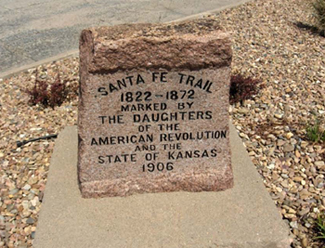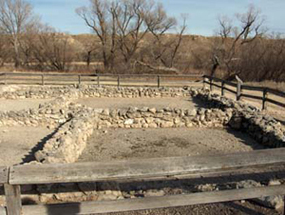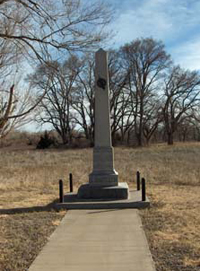Historic Preservation…a legacy of service
Marking the Santa Fe Trail

In 1902, Kansas Society DAR kicked off a campaign to place markers along the Santa Fe Trail in the state. They secured red granite boulders of varying sizes for the markers, at a cost of about $16 per boulder. At that time, there were only around 300 members in the entire state, so help from the communities was essential. By 1906, the Daughters had enough money for 70 markers and began to arrange their dedication.
One hundred years later, then State Regent Shirley S. Coupal chose as her project to survey all the DAR markers on the Santa Fe Trail in Kansas and make whatever repairs were necessary to allow them to proudly stand for another century. Bases were repaired and lettering was refurbished.
El Cuartelejo


The Kansas Society Daughters of the American Revolution owned the 60′ by 500′ tract of land containing the pueblo ruins, known as El Cuartelejo, since 1922. Situated in Scott County, the site is surrounded by Lake Scott State Park. The site is unique in that the Pueblo settlement, quite active from about 1650 until the 1680s, predates the settlement of Europeans in Kansas. By 1727, the settlement was unoccupied and fell to ruin.
Kansas Society DAR raised funds to place a monument marking the site and for its upkeep. A 12’ gray granite obelisk was placed on the site. Four granite cornerstones, engraved with DAR, mark the property lines. On October 25, 1964, a gala pageant was held, celebrating the designation of the property as a National Historic Landmark. Temporary home to several Indian tribes, the site is the northernmost site of Pueblo culture in North America.
In 1970, the Kansas State Historical Society was granted an easement for the construction, improvement, operation, and maintenance of the El Cuartelejo Pueblo for the Kansas Society DAR. The Kansas Society DAR takes pride in its eighty-five-year commitment to protecting the El Cuartelejo Pueblo ruins.
In 2005, the Kansas Society DAR, Kansas State Historical Society, and the Kansas Department of Wildlife and Parks formulated plans for an interpretive center to protect the site and furnish an interpretive experience for visitors at El Cuartelejo. In 2013, the Kansas Society DAR transferred the property to the state of Kansas for further development and preservation.
The Madonna of the Trail

In 1911, the Daughters of the American Revolution established a national committee known as the National Old Trails Road Committee whose work was, primarily, to establish the Old Trails Road as a great National Memorial Highway. The Old Trails Road, traveled by pioneers to points west, traversed twelve states from Maryland to California.
After a variety of designs were considered, the now-familiar pioneer mother statue was decided upon. Monuments were erected by state organizations of the Daughters of the American Revolution in each of the twelve states through which the National Old Trails Road passes, culminating in the week of April 19, 1929, with the twelfth monument dedication at Bethesda, Maryland. The marking of the ocean-to-ocean highway, honoring the pioneer mothers of covered wagon days, completed the memorialization of the trail of a young nation as they crossed the Allegheny Mountains to make their homes in the great western wilderness.
In the twelve states, the DAR chapters that are located nearby are known as guardian chapters of the Madonna of the Trail and may, where indicated, provide landscaping, cleaning, and whatever may be needed to maintain the statues. The Madonna of the Trail in Council Grove, Kansas, has the local Council Oak Chapter, NSDAR as its guardian.
Buildings, Battlefields and Beyond
Kansas Society DAR Daughters continues to support the National Society during these years by raising funds to install LED lights in the NSDAR Genealogy Library. Other major restoration projects at the National Headquarters were undertaken to preserve and protect our “House Beautiful.”
In anticipation of the upcoming 250th anniversary of the birth of our nation, NSDAR created the “DAR Pathway of the Patriots”. This pathway features 250 trees that serve as a living tribute to the memory and spirit of Patriots who fought to achieve independence in the American Revolutionary War. This pathway, created in conjunction with the American Battlefield Trust, is located on the historic battlefields of Yorktown. Kansas Society DAR Daughters purchased three trees to honor their ancestors: John Mitchell, Nathan Futrell, and Peter Gearhart.
In 2018, Kansas Society DAR Daughters generously donated $35,000 to renovate our beloved Kansas Chapel located at NSDAR Headquarters in Washington DC. A Kansas wood crafter was selected to design and build a new altar, narthex and memorial tables. These pieces were crafted from native Kansas Black Walnut trees. A Kansas artisan used Arnold Friberg’s iconic painting of “Prayer at Valley Forge as inspiration for a beautiful, backlit stained-glass piece framed in a shadow box constructed of the same black walnut.
The KSDAR library was established in 1930 as a traveling genealogy library and eventually, the collection found a new home in Dodge City, Kansas, in 1959. In June of 2018, a new Advanced Learning Library opened in Wichita, Kansas. In the spring of 2019, Kansas Society DAR Daughters elected to transfer all 5,600 KSDAR library holdings and archives to the Advanced Learning Library.
As the 250th anniversary of our nation has drawn closer, Kansas Society DAR Daughters have been busy placing America 250! Patriot Markers throughout Kansas. The purpose of the markers is to commemorate the men and women who achieved American independence. These Patriots believed in liberty and achieved their goal of founding a new nation. As of May 2025, there are six Patriot markers in Kansas. They are located in El Dorado, Kingman, Leavenworth, Washington, Olathe and Burrton, Kansas.

